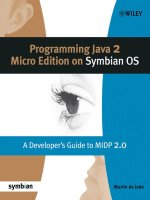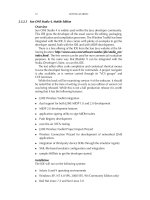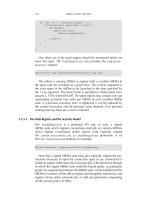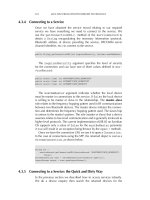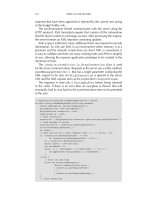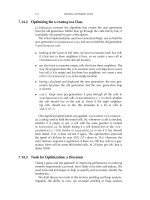Wiley games on symbian OS a handbook for mobile development apr 2008 ISBN 0470998040 pdf
Bạn đang xem bản rút gọn của tài liệu. Xem và tải ngay bản đầy đủ của tài liệu tại đây (2.71 MB, 408 trang )
Games on Symbian OS
A Handbook for Mobile Development
Games on Symbian OS
A Handbook for Mobile Development
Authors
Fadi Chehimi, Leon Clarke (Ideaworks3D), Michael Coffey, Paul
Coulton, Twm Davies, Roland Geisler, Nigel Hietala, Sam
Mason, Peter Lykke Nielsen, Aleks Garo Pamir and Jo Stichbury
(Lead author and editor)
Contributors
Sam Cartwright (Mobile Developer Lab), Tim Closs
(Ideaworks3D), John Holloway (ZingMagic), David MacQueen
(Screen Digest), Adam Taylor (Ideaworks3D) and Steve
Townsend (Great Ape Software)
Reviewed by
Michael Aubert, Jan Bonnevier, Sam Cartwright, Martin de Jode,
Brian Evans, Toby Gray, Martin Hardman, John Imhofe, Mathew
Inwood, Mark Jacobs, Erik Jacobson, Rob James, Elina Koivisto,
Kazuhiro Konishi, Mal Minhas, Ben Morris, Matthew O’Donnell,
Matt Plumtree, Lane Roberts, Jesus Ruiz, Hartti Suomela, Steve
Townsend, Shawn Van Every and Sally Vedros
Head of Symbian Press
Freddie Gjertsen
Managing Editor
Satu McNabb
Copy Editor
Lisa Voisin
Copyright 2008
Published by
Symbian Software Ltd
John Wiley & Sons Ltd, The Atrium, Southern Gate, Chichester,
West Sussex PO19 8SQ, England
Telephone (+44) 1243 779777
Email (for orders and customer service enquiries):
Visit our Home Page on www.wileyeurope.com or www.wiley.com
All Rights Reserved. No part of this publication may be reproduced, stored in a retrieval system or transmitted in any form
or by any means, electronic, mechanical, photocopying, recording, scanning or otherwise, except under the terms of the
Copyright, Designs and Patents Act 1988 or under the terms of a licence issued by the Copyright Licensing Agency Ltd,
90 Tottenham Court Road, London W1T 4LP, UK, without the permission in writing of the Publisher. Requests to the
Publisher should be addressed to the Permissions Department, John Wiley & Sons Ltd, The Atrium, Southern Gate,
Chichester, West Sussex PO19 8SQ, England, or emailed to , or faxed to (+44) 1243 770620.
Designations used by companies to distinguish their products are often claimed as trademarks. All brand names and
product names used in this book are trade names, service marks, trademarks or registered trademarks of their respective
owners. The Publisher is not associated with any product or vendor mentioned in this book.
This publication is designed to provide accurate and authoritative information in regard to the subject matter covered. It
is sold on the understanding that the Publisher is not engaged in rendering professional services. If professional advice or
other expert assistance is required, the services of a competent professional should be sought.
The Publisher and the Author make no representations or warranties with respect to the accuracy or completeness of the
contents of this work and specifically disclaim all warranties, including without limitation any implied warranties of
fitness for a particular purpose. The advice and strategies contained herein may not be suitable for every situation. In
view of ongoing research, equipment modifications, changes in governmental regulations, and the constant flow of
information relating to the use of experimental reagents, equipment, and devices, the reader is urged to review and
evaluate the information provided in the package insert or instructions for each chemical, piece of equipment, reagent, or
device for, among other things, any changes in the instructions or indication of usage and for added warnings and
precautions. The fact that an organization or Website is referred to in this work as a citation and/or a potential source of
further information does not mean that the author or the publisher endorses the information the organization or Website
may provide or recommendations it may make. Further, readers should be aware that Internet Websites listed in this work
may have changed or disappeared between when this work was written and when it is read. No warranty may be created
or extended by any promotional statements for this work. Neither the Publisher nor the Author shall be liable for any
damages arising herefrom.
Copyright 2007 Nokia. All rights reserved. Nokia, N-Series, N-Gage QD, N-Gage Arena, Space Impact, Pathway to
Glory, High Seize, Pro Series Golf, System Rush: Evolution and Mile High Pinball are trademarks or registered trademarks
of Nokia Corporation.
Other product and company names mentioned herein may be trademarks or trade names of their respective owners.
The Bluetooth word mark and logos are registered trademarks owned by Bluetooth SIG, Inc. and any use of such marks
by Symbian Software Ltd is under license. Other trademarks and trade names are those of their respective owners.
All trademarks and logos that contain Java are trademarks or registered trademarks of Sun Microsystems, Inc. in the
United States and other countries
Other Wiley Editorial Offices
John Wiley & Sons Inc., 111 River Street, Hoboken, NJ 07030, USA
Jossey-Bass, 989 Market Street, San Francisco, CA 94103-1741, USA
Wiley-VCH Verlag GmbH, Boschstr. 12, D-69469 Weinheim, Germany
John Wiley & Sons Australia Ltd, 42 McDougall Street, Milton, Queensland 4064, Australia
John Wiley & Sons (Asia) Pte Ltd, 2 Clementi Loop #02-01, Jin Xing Distripark, Singapore 129809
John Wiley & Sons Canada Ltd, 6045 Freemont Blvd, Mississauga, Ontario, L5R 4J3, Canada
Wiley also publishes its books in a variety of electronic formats. Some content that appears
in print may not be available in electronic books.
British Library Cataloguing in Publication Data
A catalogue record for this book is available from the British Library
ISBN: 978-0-470-99804-5
Typeset in 10/12pt Optima by Laserwords Private Limited, Chennai, India
Printed and bound in Great Britain by Bell & Bain, Glasgow
This book is printed on acid-free paper responsibly manufactured from sustainable forestry
in which at least two trees are planted for each one used for paper production.
Contents
Forewords
ix
About this Book
xiii
About the Authors
xvii
Editor’s Acknowledgements
xxiii
Part One: A Symbian Perspective
on Mobile Games
1 Introduction
1.1
1.2
1.3
1.4
1.5
1.6
1.7
1.8
1.9
1.10
1.11
1.12
1.13
1.14
Why Games?
What Is Symbian? What Is Symbian OS?
Some Statistics
Games Platforms Compared
Types of Mobile Games
Who Plays Mobile Games?
Who’s Who in Mobile Game Creation?
Mobile Game Distribution: Routes to Market
The User Experience
Mobile Game Platforms
Portability and Compatibility
Smartphone Characteristics
The Future for Games on Symbian Smartphones
Summary
1
1
2
6
10
13
16
17
20
25
27
32
37
38
40
vi
CONTENTS
Part Two: Creating Native Games
on Symbian OS v9
2 Symbian OS Game Basics
2.1
2.2
2.3
2.4
2.5
2.6
2.7
2.8
2.9
Introduction
The Game Loop
The Heartbeat Timer
Handling Input from the Keypad
Handling Input from the Screen
System Events
Memory Management and Disk Space
Maths and Floating Point Support
Tools and Further Reading
3 Graphics on Symbian OS
3.1
3.2
3.3
3.4
3.5
3.6
3.7
3.8
3.9
3.10
3.11
3.12
3.13
3.14
Introduction
Overview
On Frame Rate
About Display Memory
A Primer on Drawing on Symbian OS
Direct Screen Access
Double Buffering and Anti-Tearing
Pixel Color Representations
Loading and Manipulating Images
Scaling for Variable Screen Sizes and Resolutions
Rendering Text
Playing Video Clips
Less Useful APIs
Summary
4 Adding Audio to Games on Symbian OS
4.1
4.2
4.3
4.4
4.5
4.6
Introduction
Multimedia Framework (MMF)
Sound Effects
Background Music
Best Practice in Mobile Game Audio
What’s Next?
5 Multiplayer Games
5.1
5.2
5.3
5.4
Introduction
Local Multiplayer Games Over a Bluetooth
Connection
Online Multiplayer Games
Airplay Online: A Multiplayer SDK and Service
Solution
43
43
43
46
49
52
54
57
59
60
61
61
62
64
67
68
75
83
90
97
105
111
115
121
121
123
123
124
128
142
150
151
157
157
159
160
165
CONTENTS
5.5
5.6
5.7
N-Gage Arena
Other Online Multiplayer Solutions
Further Reading
6 Exploiting the Phone Hardware
6.1
6.2
6.3
6.4
6.5
6.6
6.7
Introduction
Camera
Location
3D Motion Sensors
Vibration
Summary
Acknowledgements
vii
171
174
174
175
175
178
188
198
207
216
216
Part Three: Porting Games to Symbian OS
7 C/C++ Standards Support for Games Developers
on Symbian OS
7.1
7.2
7.3
7.4
7.5
7.6
7.7
7.8
7.9
7.10
7.11
P.I.P.S. Is POSIX on Symbian OS
Open C
OpenKODE
OpenVG
OpenMAX
OpenSL ES
EGL
OpenGL ES
Get Your Fix
Enough Already!
Further Reading
8 The N-Gage Platform
8.1
8.2
8.3
8.4
8.5
8.6
A Brief History of N-Gage
N-Gage Platform: The Next Generation of Mobile
Gaming
The N-Gage SDK
The N-Gage Application
Becoming an N-Gage Developer
Summary
217
217
220
224
227
228
229
230
231
234
236
237
239
239
244
248
256
262
264
viii
CONTENTS
Part Four: Java ME, DoJa and Flash Lite
on Symbian OS
9 MIDP Games on Symbian OS
9.1
9.2
9.3
9.4
9.5
9.6
9.7
9.8
9.9
9.10
9.11
9.12
Introduction
Java ME 101
To Java ME or Not To Java ME?
Tools and SDKs
What About MIDP on Symbian OS?
Pausing for Breath
Living it Up
Game Architecture
Case Study: Third Degree
Did You Hear That SNAP?
And Another Thing . . .
Further Reading
10 Games In Japan
10.1
10.2
10.3
10.4
10.5
10.6
10.7
10.8
10.9
265
265
265
270
271
272
274
277
280
282
289
293
294
297
Introduction
The Japanese Market
Enter DoJa!
DoJa 2.5 Overview
Porting MIDP to DoJa
DoJa and Eclipse
Mascot
Tokyo Titles
At The End Of The Day
297
297
299
302
310
313
316
318
319
11 Flash Lite Games on Symbian OS
321
11.1
11.2
11.3
11.4
11.5
Introduction
Flash Lite on Mobile Phones
Flash Lite Overview
Flash Lite Development Tools
Flash Lite Ecosystem
321
323
324
329
335
References and Resources
337
Appendix: Airplay
341
Index
351
Foreword
Tim Closs, Chief Technology Officer, Ideaworks3D Ltd
The mobile phone is not primarily a platform for playing games, and
Symbian OS is not primarily a platform for writing games. So why are
you here, at the opening pages of a book devoted to the subject of mobile
games on Symbian OS?
I don’t have to tell you about the revolution that has happened
(and is still happening) in mobile phone hardware. Phones today are
unrecognizable from the cumbersome black boxes we see in 1980’s
video clips, proudly displayed as fashion accessories by loud-mouthed
stockbrokers. One mobile phone manufacturer today describes their
flagship range as ‘multimedia computers’ – and we can see why. High
resolution, sharp and brightly-lit screens, many megabytes of memory,
fast processors, and even hardware graphics acceleration, these all add
up to a very powerful piece of computing hardware. Whilst it may be
true that voice communication and text messaging are still the most
popular services, phones are increasingly being relied upon for email,
web browsing, and entertainment such as music, video, mobile TV,
and games.
Network operators derive revenue by encouraging users to download
content to their phone. Until recently, the primary drivers for these
revenues were ‘wallpapers’ (images displayed on the phone’s front screen)
and ringtones. However, as this book will explain, over the last year many
operators have seen game revenues overtake other content types. This is
due partly to the increase in the quality and variety of games on offer, but
also to the improved user experience offered by operators to consumers
when searching for and choosing to download a game.
Symbian OS is the leading smartphone operating system in the world
today, occupying over 90 % of the European market, large swathes of the
x
FOREWORD
Asian markets and elsewhere. In addition, Symbian OS has evolved over
many, many years and is arguably a more mature and well-understood
platform than many of its competitors. As such, Symbian OS is an excellent
choice for mobile games developers looking to develop expertise and
deploy to a wide consumer base.
Ideaworks3D is a leading developer of advanced mobile games and
enabling technologies for cross-platform mobile game development. Our
BAFTA award-winning studio collaborates with the industry’s leading
mobile and video game publishers to mobilize their flagship game franchises, including Final Fantasy VII (Square Enix), Need for Speed and
The Sims 2 Mobile (EA Mobile). We also innovate to create original
games for handheld and mobile platforms, including such games as
System Rush: Evolution (Nokia). We have been developing games for
Symbian OS since 2002. We were heavily involved in the launch of
Nokia’s N-Gage game decks (a handset designed specifically for playing
mobile games, based on Symbian OS 6.1) in 2003. We are now equally
involved in the next generation of N-Gage, as a platform that allows
high-quality games on many of Nokia’s flagship smartphones. We have
also deployed games to all of the open native operating systems in the
world today. As such, we believe we have some valuable insights into
mobile game development on all platforms, including Symbian OS. We
have passed on some of our experience within this book.
Our excitement for mobile games remains undimmed, and we believe
the future for the industry is brighter than ever.
Foreword
Antony Edwards, VP Developer Product Marketing, Symbian Ltd
Game development has always been at the bleeding edge of technology.
In 1984, when IBM first tried to enter the personal computer market with
the IBM PCjr, they ensured Sierra On-Line’s King’s Quest was there for
the launch. Game consoles were the first multi-processor computers to
make it into most people’s lives, and game developers have used the
connectivity provided by the Internet to revolutionize their games more
than any other software genre. We’ve seen NetHack on more prototype
operating systems than we can remember. And, though it’s not talked
about, I’m sure that there was a game hidden away in the accumulators
of the ENIAC somewhere. . .
Mobile devices present the next great adventure for game developers.
Mobile devices are always connected, always at hand, and often include
features such as location-based services and a camera, which provide a
canvas for game developers to create the most engaging experiences yet.
This book is dedicated to helping game developers create and define
this new genre of mobile games on Symbian smartphones. Symbian OS is
the world’s most popular smartphone operating system, having shipped in
over 145 million devices across 120 models. Symbian licenses Symbian
OS to the world’s leading handset manufacturers and works closely with
all leading companies across the mobile industry to help create new and
compelling mobile experiences.
Symbian has been an innovator in multimedia and graphics since the
beginning. Symbian OS was the first smartphone OS to support OpenGL
ES for mobile 3D graphics in 2004. We recently announced a major
new graphics architecture that supports OpenVG, OpenGL ES 2.0, and
OpenWF Composition API. Symbian OS v9.5 is set to deliver higher
performance and richer graphics. What will developers do with all our
xii
FOREWORD
new technology? We’re not entirely sure, but we are sure it’s going to
be exciting. That’s the great part of being the world’s leading mobile
operating system.
Symbian is also making it easier to port existing games to our smartphone platforms. The P.I.P.S. and Open C initiatives for POSIX-compliant
C/C++ development, support for standards such as OpenGL ES, and our
open platform for middleware solutions all make Symbian OS flexible for
professional developers to migrate games to our smartphones. What better demonstration of this could there be than Olli Hinkka’s open source
port of Quake for S60 3rd Edition Feature Pack 1 smartphones, which
uses the P.I.P.S. libraries to recreate that pre-eminent shoot ‘em up in all
its gory glory?
The authors bring a wealth of experience from both the game industry
and Symbian OS development to this book. Whether you are new to
writing mobile games, or are already an experienced game developer,
you will find it invaluable. It covers Symbian OS game development
using C, C++, Java ME, DoJa, and Flash Lite. We hope it will spark your
imagination to create games for our next generation of smartphones.
About this Book
This book forms part of the Symbian Press Technology series. It describes
the key aspects of the mobile game market, with particular emphasis on
creating games for smartphones based on Symbian OS v9.x.
What Is Covered?
This book divides into four parts. The first part introduces the world of
mobile games. It aims to explain what mobile games are, who plays them,
who writes and sells them, how they sell them and what the major issues
are in the marketplace. We’ll look at some statistics for the sales of mobile
games and mobile phones, and make comparisons with game consoles,
handheld systems and PC games. The first chapter is not technical and
is suitable for anyone interested in finding out more about the mobile
games industry. However, there is an excursion into the differences
between BREW, Java ME and native C++ games, a brief foray into issues
of compatibility and portability, and a short introduction to some of the
aspects of game development that characterize any mobile platform. So
there’s something for developers too: topics are introduced gradually,
with signposts directing readers where to go for more information within
the rest of the book – and beyond.
The second part of the book covers various technical areas associated
with creating games in C++ on Symbian OS v9 smartphones (using the
native APIs provided by UIQ 3 or S60 3rd Edition SDKs). Chapter 2 covers
the basics of writing a game in Symbian C++, Chapter 3 delves deep into
the Symbian OS graphics architecture, Chapter 4 deals with adding audio
to games, and Chapter 5 discusses the issues associated with creating a
multiplayer game. The final chapter in this part of the book is Chapter 6,
xiv
ABOUT THIS BOOK
which discusses how to be innovative and create novel and appealing
gameplay by using phone functionality, such as motion detection, the
camera, the vibra or location-based services.
The third part of the book is for game developers who are interested
in porting games without using just the native Symbian OS C++ APIs.
Chapter 7 discusses the various standards support available on Symbian
OS, such as POSIX-compliant standard C libraries, OpenKODE and
OpenGL ES. Chapter 8 describes the Nokia N-Gage platform, which
is Nokia’s initiative to bring high quality games to S60 3rd Edition
smartphones by providing a platform for professional game developers to
port their game code using standard C and C++. N-Gage is more than
an SDK and comprises an end-to-end solution for users to discover, play,
and share games, and in Chapter 8, we’ll discuss how developers work
with Nokia to achieve this.
The final part of the book is for developers who want to write games for
Symbian smartphones without using C or C++ at all. Chapter 9 describes
the support available for Java ME on Symbian OS, and walks through
an example game. The same author then explores the DoJa standards
available for creating Java games for installation to Symbian smartphones
in Japan, where the majority of phones are supplied by NTT DoCoMo
and a different set of rules for application creation and distribution apply.
The last chapter of this section, and the book, describes game creation
using Flash Lite 2, which is supported on S60 3rd Edition smartphones
and Symbian smartphones in Japan.
This book doesn’t present a single example of a game that it builds
from scratch throughout the book, because we find that this approach
tends to constrain the text, and the reader, to the details of the example.
Instead, we’ve used a number of different examples for each chapter;
these have been tailored specifically to illustrate the topic in question.
Where possible, we have avoided using large chunks of example code in
the technical chapters of the book, and have instead put the code, in full,
on the website for this book developer.symbian.com/gamesbook.
If you would like to read more about the creation of a full game
example in C++ on Symbian OS, we highly recommend a paper on the
Symbian Developer Network by one of the authors of this book, Twm
Davies. The Roids paper (developer.symbian.com/roidsgame) explains
the design, implementation and optimization of an Asteroids clone for
Symbian OS v9. The example code and installation files for both S60 3rd
Edition and UIQ 3 phones can also be downloaded from the website.
Recommendations for other papers and code downloads for full game
examples can be found in the References and Resources section at the
end of this book.
ABOUT THIS BOOK
xv
Please also take a look at the book’s page on the Symbian Developer
wiki (developer.symbian.com/wiki/display/academy/Games+on+
Symbian+OS) for a set of useful links to other mobile game developer
resources, and an errata page for the book. Do feel free to visit it regularly
and to contribute.
Who Is this Book for?
The typical reader may be:
• a C++ or Java ME developer already creating applications or services
on Symbian OS who wants to take advantage of the growth in
commercial mobile games
• anyone in the game industry (e.g., a professional or hobbyist developer, game producer or designer) who wants to target games for
Symbian OS
• a developer new to Symbian OS who wants to learn about the platform
and is experimenting by creating a game.
But we don’t like to stereotype our readers, and hope that if you don’t
fit into these categories, you’ll still find something of interest in this book!
The technical chapters assume that you have a working knowledge
of either C++ on Symbian OS or Java ME. The basic idioms of Symbian
C++ and details, such as how to get a working development environment
or how to create ‘Hello World,’ are not to be found in this book,
which is instead dedicated to the specifics of mobile game creation
on Symbian smartphones. However, if you need general information
about developing on Symbian OS, it can be found in other titles in the
Symbian Press series, and in a number of free papers available on the
Symbian Developer Network website and other Symbian OS community
development websites. A list of the current Symbian Press series of books
can be found in the References and Resources section at the end of the
book.
About the Authors
Jo Stichbury
Jo has worked within the Symbian ecosystem since 1997, in the Base,
Connectivity, and Security teams of Symbian, as well as for Advansys,
Sony Ericsson and Nokia. At Nokia, she worked in the N-Gage team,
providing technical support to game developers worldwide, and while
there, she discovered that it is possible to play games at work legitimately.
There’s been no going back, and she’s now trying to think up an excuse for
playing Spore professionally for Symbian Press, whilst eagerly awaiting
the game’s release.
Jo is author of Symbian OS Explained: Effective C++ Programming
for Smartphones, which was published by Symbian Press in 2004. She
co-authored The Accredited Symbian Developer Primer: Fundamentals
of Symbian OS, with her partner, Mark Jacobs, published by Symbian
Press in 2006.
Jo became an Accredited Symbian Developer in 2005 and a Forum
Nokia Champion in 2006 and 2007.
Twm Davies
Twm graduated in 1999 from Cardiff University with a First Class BSc
in Computer Science, where he specialized in computer graphics and
artificial intelligence. After uni, he moved to London where he worked
at Symbian for seven and a half years as an engineer, consultant, and
product manager helping Symbian licensees get their first phones out of
the door.
xviii
ABOUT THE AUTHORS
At present, Twm is a freelance consultant on smartphone projects (or
Ronin as he prefers to call it) and a regular contributor of book chapters
and technical papers to the Symbian community. Twm wrote his first
game at age 12 in Amos Basic, and his favorite game is Chaos Engine by
the bitmap brothers (for its steam punk stylings).
Aleks Garo Pamir
Aleks graduated from Bogazici University in Turkey with an Associate
degree in Computer Programming. He also has a BA in Labor Economics
from Istanbul University and an MA in Industrial Relations from Marmara
University. He spent a few years in Bogazici University as a teaching
assistant in the MIS department.
During his education Aleks worked as a columnist and editor for local
games review magazines in Turkey including PC World/Turkey. He was
also a member of the team that developed the first Turkish RPG Istanbul
Efsaneleri - Lale Savascilari for PCs. He worked as a software developer
in Turkey for a number of years, developing software for a diverse set
of industries using multiple different languages. After the emergence
of cellular networks, he decided to focus on mobile technologies, and
Symbian became his first choice.
Aleks moved to Canada in 2003 and founded Capybara Games, a
mobile game company. Aleks became an Accredited Symbian Developer in 2007. He lives in Vancouver with his wife Zeynep and is
currently working for Intrinsyc Software International as a senior software
developer.
Michael Coffey
Michael joined Symbian as a graduate in 2004 after obtaining an MEng in
Electronic and Electrical Engineering from the University of Birmingham.
He has since worked in the PIM team specializing in the calendar and
alarm server components. In his spare time, he has worked on creating
Symbian mobile games. He is an Accredited Symbian Developer.
Leon Clarke
Leon Clarke has been working in embedded and mobile computing for
over 15 years. He worked at Symbian for six years in various capacities,
working on web browsing technologies and system software, before moving to Ideaworks3D four years ago, where he has been the chief architect
of Ideaworks3D’s online gaming product, Airplay Online. Leon has been
ABOUT THE AUTHORS
xix
actively involved in the Khronos Group’s Open KODE standardization
process, being one of the major contributors to the Open KODE core.
Paul Coulton
Paul is a senior lecturer based within the Department of Communication Systems at Lancaster University. When he first left university, Paul
worked for various small games developer teams primarily on algorithm
design, before utilizing his skills in the defence industry on simulators.
In 1997, he completed a PhD in Mobile Systems and, although his early
work was primarily associated with HDSPA, he switched to application
development in 2000. The main focus of his current research surrounds
innovative mobile social software with a particular emphasis on mobile
entertainment, such as games. He was the first academic invited to speak
at the Mobile section of the Game Developers Conference and was one
of the founding Forum Nokia Champions in 2006, re-selected in 2007.
Paul has published widely (including a Symbian Press book on S60
development) and a lot of his research projects encompass novel uses
of the latest technologies, such as RFID/NFC, cameras, GPS, and 3D
accelerometers in mobile phones.
Because his research encompasses a great deal of HCI, Paul is a big
fan of the Wii and the DS, although his favorite game is the old mega
drive classic Toejam and Earl2, principally because it had a soundtrack
by the master of funk, George Clinton.
Fadi Chehimi
Fadi is a mobile phone software engineer at Mobica Ltd. and a final year
PhD student at the Department of Communication Systems at Lancaster
University, UK. During his employment, Fadi has worked intensively on
Symbian OS and Windows Mobile platforms. He has had his hands on
several new devices and technologies before they were released into the
market and for him this is part of the joy of mobile development. During
his research he worked on several projects related to 3D graphics and
mobile advertising. His main focus is on utilizing mixed reality technology
for business and entertainment applications on mobile phones, and for
that he has developed several proof-of-concept prototypes.
Sam Mason
Sam came to computing late in life, after spending three years studying civil engineering – where he first learned to program using Pascal.
Unusually, he didn’t have a Commodore 64, had never heard of a Z80,
xx
ABOUT THE AUTHORS
didn’t write compilers at age 7, and still can’t use a soldering iron! After
an abortive attempt at trying to become a vet, Sam eventually graduated
with a Computer Science degree from the University of New South Wales
in Sydney in 1996.
He ran straight into the dot com boom as a contract programmer in
eCommerce, building HR and legal extranets, as well as workflow and
content management systems for a number of short-lived companies,
using Java and C++. After spending about two years working on a
Java-based multi-lingual video-on-demand system for Singtel and other
APEC telcos, he’s spent most of the last four years working with and
learning about mobile phone technologies, while picking up a couple of
Java certificates and completing a Masters of Information Technology in
Autonomous Systems from UNSW along the way.
Having spent most of his professional career in fascinating sectors like
accounting, finance, and payroll, he’s become somewhat of a mobile
technology and artificial intelligence evangelist these days. To that end,
he started Mobile Intelligence in 2006 and became the first to sit the
supervised Accredited Symbian Developer (ASD) exam in Australia, in
March 2007.
Sam is happily married with three little ones who are all at pre-school,
they have no cats or birds, even fewer dogs, and is currently working
full-time as a mobile technology consultant based in Sydney.
Roland Geisler
Roland Geisler currently serves as Group Product Manager for Nokia
and is responsible for the Nokia N-Gage product strategy and the global
product management for the N-Gage application for Nokia smartphones.
Roland joined Nokia in 2001, and has held various management positions
in Europe and the US, including Head of Marketing and Strategy, and
Technology Manager for the Nokia Mini Map Browser, project manager
for a number of mobile application software projects, and Development
Partner Manager for Opera Software, a Nokia software supplier. Before
he joined Nokia, Roland worked as a product manager and software
engineer at Gigabeat (acquired by Napster) in Silicon Valley. Prior to this,
he was a research assistant at the National Center for Supercomputing
Applications (NCSA). Roland earned an MS in Computer Science from the
University of Illinois at Urbana-Champaign and his undergraduate degree
in Computer Science and Economics from the Technische Universit¨at
Munchen
¨
in Germany.
Peter Lykke Nielsen
Peter Lykke Nielsen started his career in the interactive entertainment
industry back in early 1995, when he was part of the trio setting up and
ABOUT THE AUTHORS
xxi
running the independent game developer Scavenger. As well as being
part of building the company, he also oversaw a number of titles in
development. In the late nineties, after having relocated to England, he
joined Activision as a Producer and worked with them on Rome: Total
War and Rally Fusion: Race of Champions plus a number of their Disney
and Star Trek branded titles. In 2004, he relocated to Canada, where he
initially worked as a Producer for EA on Need for Speed: Most Wanted.
Subsequently, he joined Nokia to become part of the team that will
launch the next generation of the N-Gage platform. In his current role
as Product Manager for the N-Gage SDK, Peter Nielsen is responsible
for researching, defining, and communicating the feature set required to
create cutting edge N-Gage titles.
Samuel (Sam) Cartwright
Samuel graduated from Griffith University, Australia, with a BIT in 2000.
Shortly thereafter, he joined an outsourcing firm in Tokyo specializing
in development for the telecommunications industry. While there, he
worked as a Windows application developer creating low-level protocol
encoders and UML tools before a briefly working on a mobile phone
MMI (man machine interface) using the Apoxi framework.
In 2005, Sam joined Gameloft K.K., where he is now a senior programmer. As a game programmer, Sam both codes original titles on MIDP
and ports games from MIDP to DoJa. In his spare time he also runs the
Mobile Developer Lab mobile programming site, and is completing an
MBA from Charles Sturt University.
Outside of work, Sam enjoys working out at the gym and attempting
to read manga in Japanese.
Nigel Hietala
Nigel Hietala is a User Interface Specialist working for Nokia on the S60
platform. He has worked for over a decade with mobile devices and
always at companies using Symbian OS. He caught the programming bug
while originally building UI prototypes of future designs with Flash MX
and, much to the dismay of his designer colleagues, has been delving
ever deeper into the world of Flash and software development.
He still loves computer games and imagines a time when his four
children have grown up enough that he can play them again.
